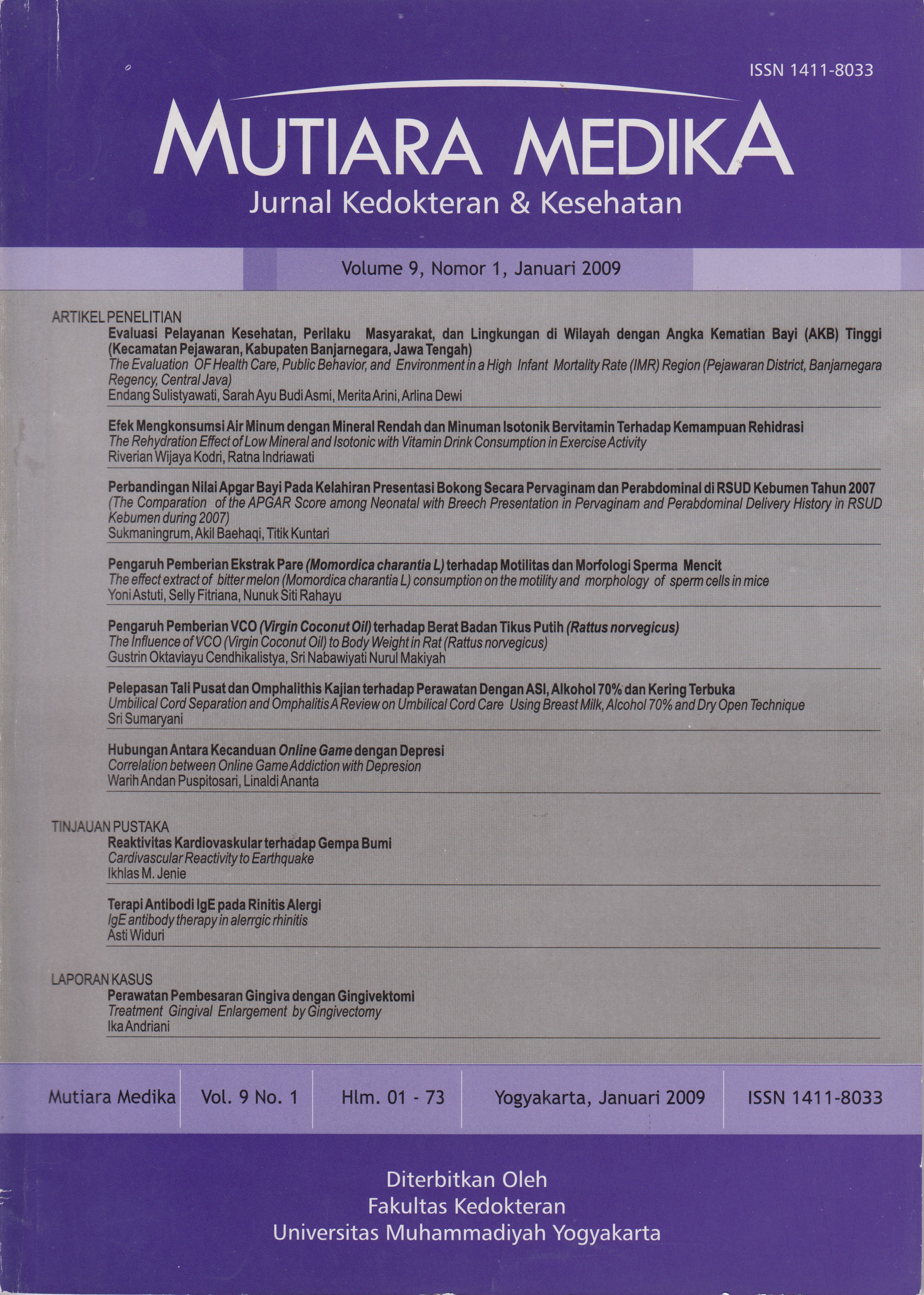Pengaruh Pemberian Ekstrak Pare (Momordica charantia L) terhadap Motilitas dan Morfologi Sperma Mencit
DOI:
https://doi.org/10.18196/mmjkk.v9i1.1588Keywords:
Ekstrak pare, kontrasepsi, motilitas, morfologi spermatozoa, spermatogenesis, sperma, Bitter melon extract, contraception, motility, sperm, sperm morphologyAbstract
The role of man in Family Planning extend o the birth space is rare. Therefore, improvement efforts to create the family planning tools that have characteristic safe and reversible for man ’s reproductive system are needed.It is wellknown that pare (Momordica charantia,L) showed the effect of spermatogenesis inhibition. The aim of this study is to reveal the influence of bitter melon extract on mice sperm activity. This experimental study used male mice which were given bitter melon extract by oral intubations. Twenty mice were divided into 2 groups. Group A was treated with bitter melon extract for 4 weeks and group B for 6 weeks. Each group were further divided into 5 subgroups which were treated with different dose 500, 600, 700, 800 mg/kg body weight/day and control subgroups were treated with aquadest. After this, mice were decapitated, and the left and right terminals of the epididymis were sectioned. Then the motility and morphology of the sperms cells were examined cupically. The results showed that there was a correlation between dose of extract, motility and morphology of sperms. The ANOVA analysis showed that there were significants differenced, at motility A(r = - 0,583), B(R = - 0,839) p = 0,27, normal morphology A(r = - 0,946), B(r = - 0,962) p = 0,000, abnormal morphology A(r = 0,930), B(r = 0,962) p = 0,000. It is concluded that the decreasing of motility and normal morphology of sperms were liniar with the increasing of dose and duration of extract treatment for sperm motility. The most minimally effective dosage were : 500 mg/weight/day during 4 weeks.
Peran pria dalam mengikuti program Keluarga Berencana (KB) untuk menjaga jarak kelahiran anak masih sangat sedikit. Sehingga perlu usaha untuk menciptakan alat KB yang aman dan bersifat sementara bagi pria. Pare (Momordica charantiaL) diketahui memiliki efek penghambatan spermatogenesis. Penelitian ini menggunakan metode eksperimental. Mencit sebanyak 20 ekor terbagi dalam 2 kelompok. Kelompok A (kelompok diberi perlakuan selama 4 minggu dan kelompok B (kelompok yang diberi perlakuan selama 6 minggu). Tiap kelompok terdiri dari 5 sub kelompok dengan dosis berbeda, yaitu 500, 600, 700, 800 mg ekstrak pare/kg BB/hari dan sub kelompok kontrol yang diberi aquadest. Setelah masa perlakuan, mencit didekapitasi, epididimis bagian akhir dari saluran reproduksi sebelah kanan dan kiri diambil, dibuat suspensi dengan NaCl 0,9%. Dihitung motilitas sperma ,dihitung morfologi normal dan morfologi tidak normal. Hasil penelitian ini menunjukkan adanya korelasi antara dosis ekstrak dengan motilitas pada kelompok A : (r = -0,583) sedang pada kelompok B : (r = -0,839) dan korelasi dosis dengan morfologi sel sperma normal pada kelompok A : (r = -0,946), pada kelompok B : (r = -0,962) dan korelasi dosis dengan kelompok abnormal pada kelompok A : (r = 0,930) , pada kelompok B : (r = 0,962).Sedangkan uji ANOVA menunjukkan adanya beda nyata , yaitu antara dosis dengan pada motilitas p = 0,27 antara dosis dengan p = 0,000, morfologi abnormal p = 0,000. Disimpulkan bahwa penurunan motilitas dan morfologi sperma berbanding lurus dengan peningkatan dosis dan lama perlakuan. Dosis efektifminimal adalah 500mg/BB/hari selama waktu 4 minggu.
References
Tadjudin, M.K., (1984), Tujuan Kontrasepsi Pada Pria : Oligozoospermia, Azoospermia, Asepermia?. MKI. Vol 34. No. 11. 30 Nopember 1984.
Wuryantari (1990), pengaruh ekstrak pare terhadapo testosterone mencit. Fakultas Biologi UGM.
Harminani (1990), Pengaruh ekstrak pare terhadap kualitas spermatozoa. Fakultas Biologi UGM.
Nunuk, S.(1991). Pengaruh Ekstrak Pare (Momordica charantia L.) terhadap Spermatogenesis pada mencit jantan (Mus musculus) jantan.
Skripsi Fakultas Biologi Universitas Gadjah Mada Yogyakarta, Yoogyakarta.
Salisbury, G. W dan Vandemark, N.L (1985). Fisiologi Reproduksi Dan Inseminasi Buatan Pada Sapi. Diterjemahkan oleh Djanur, R. Gadjah Mada University Press.
Fransworth, N.R. and D.P. Waller, (1982). Current Status of Plant Product Reported to Inhibit Sperm, Research Frontiers in Fertility Regulation, vol 2. No 1 June.
Hafes, E.S.E. (1987). Reproduction in Farm Animal. 5th Ed. Lea and Febiger. Philadelphia
Toelihere. MR. (1985). Fisiologi Reproduksi pada Ternak. Penerbit Angkasa. Bandung.
Moeloek, N. (1987), Standarisasi Analisis Semen Manusia, Perkumpulan Kontrasepsi Mantap Indonesia, Jakarta.
Downloads
Published
Issue
Section
License
Copyright
Authors retain copyright and grant Mutiara Medika: Jurnal Kedokteran dan Kesehatan (MMJKK) the right of first publication with the work simultaneously licensed under an Attribution 4.0 International (CC BY 4.0) that allows others to remix, adapt and build upon the work with an acknowledgment of the work's authorship and of the initial publication in Mutiara Medika: Jurnal Kedokteran dan Kesehatan (MMJKK).
Authors are permitted to copy and redistribute the journal's published version of the work (e.g., post it to an institutional repository or publish it in a book), with an acknowledgment of its initial publication in Mutiara Medika: Jurnal Kedokteran dan Kesehatan (MMJKK).
License
Articles published in the Mutiara Medika: Jurnal Kedokteran dan Kesehatan (MMJKK) are licensed under an Attribution 4.0 International (CC BY 4.0) license. You are free to:
- Share — copy and redistribute the material in any medium or format.
- Adapt — remix, transform, and build upon the material for any purpose, even commercially.
This license is acceptable for Free Cultural Works. The licensor cannot revoke these freedoms as long as you follow the license terms. Under the following terms:
Attribution — You must give appropriate credit, provide a link to the license, and indicate if changes were made. You may do so in any reasonable manner, but not in any way that suggests the licensor endorses you or your use.
- No additional restrictions — You may not apply legal terms or technological measures that legally restrict others from doing anything the license permits.






